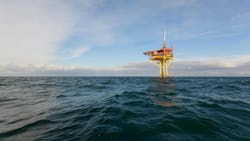UK North Sea can become Europe’s CCS hub, one well at a time
Key Highlights
- The UK can become Europe’s CO2 storage hub, leveraging its offshore geology, engineering expertise, and existing assets to attract international CO2 flows and revenue.
- Addressing challenges such as well integrity, policy frameworks, and space congestion in the North Sea is critical for the industry’s growth and sustainability.
- Integrating CCS with decommissioning efforts offers opportunities to repurpose infrastructure, optimize costs, and strengthen the offshore supply chain for future decarbonization projects.
By George Morrison, CEO, Aquaterra Energy
Carbon capture and storage (CCS) is moving from concept to execution. For years, it has been positioned as a critical part of the UK’s energy transition and broader energy and industrial strategy, but recent progress shows that we are steadily moving beyond ambition.
The UK’s Industrial Strategy, bolstered by announcements of planned funding for Projects Acorn and Viking, is sending a clear signal that CCS is a live industrial opportunity. The Northern Endurance Partnership’s (NEP) forward momentum marks the first wave of real delivery.
With contracts awarded to major onshore and offshore contractors and the first CO2 storage wells now in development for the UK’s East Coast Cluster, this is a shift that brings confidence for developers, engineers and the wider supply chain. It is often said that a project is not really real until someone starts spending money on steel work – well, now they are.
Europe’s CO2 storage hub
The UK has a stated ambition in its industrial strategy to become Europe’s CO2 storage hub. Not just a leader in capturing and storing its own emissions, but the place where other countries send theirs. With nearly a third of Europe’s CO2 storage capacity located offshore in the UK, the country is uniquely positioned to serve as a key player in the growing European carbon market.
Think of it like Sweden’s renowned waste-to-energy system, where the country imports millions of tonnes of trash from neighbors and turns it into significant revenue, jobs and opportunity. Similarly, the UK could become the place where other nations send their CO2, generating a market which the CCS association forecasts could be worth £30bn by 2050. This would not only provide a decarbonization solution but also create a valuable new industrial sector, positioning the UK as a leader globally generating valuable revenue streams and attracting and retaining talent.
There are several reasons to think that the UK is uniquely well positioned to capitalize on this opportunity. One of those is its unrivalled understanding of its offshore geology and storage opportunities. Decades of mapping, modelling and extracting from offshore reservoirs mean that the UK boasts the most extensive and comprehensively understood offshore geology in Europe, complete with proven wells, detailed pressure data and robust integrity records.
But geology is just the foundation. The UK’s edge comes from industrial capability, supportive regulation, and offshore infrastructure. Few countries in Europe can rival the UK’s concentrated engineering expertise, directly applicable to CCS. Add the potential for repurposing of existing assets and decades of offshore coordination, and it is evident that the UK has the people, ideas, and locations needed for leadership in this space.
Challenges ahead
Of course, building an industry of this scale is not straightforward. The first wave of CCS projects will face both technical and commercial hurdles, and it is important to remain realistic about what lies ahead. On the technical side, CCS will be built one well at a time – some new, some decades old, and each with its own technical, permitting and safety challenges. Success will depend on finding solutions that can be applied repeatedly across different sites, in the same way standardized approaches helped wind and oil and gas scale efficiently.
One important consideration for scaling offshore carbon storage is the re-entry and re-abandonment of legacy wells that intersect with potential storage sites. These wells were drilled and abandoned long before CO2 storage was considered, and unless they are safely re-entered and re-abandoned, they risk becoming leakage pathways that could compromise future storage. Conventional methods such as drilling a relief well to intersect and seal an old well are slow, expensive and have no guarantee of success, particularly when aging casings increase the risk of further damage during the process.
Fortunately, new approaches are emerging to meet this challenge. One is the Recoverable Abandonment Frame (RAF), now being deployed on the NEP project to enable safe re-entry and re-abandonment. The RAF overcomes the main limitations of conventional methods by allowing precise vertical well intervention, providing structural support and reducing the risk of damaging degraded casings. Because it is modular and reusable, it can be moved quickly between wells, cutting both time and cost. Innovations like this are essential to ensure that legacy wells do not become barriers to large scale CO2 storage but are addressed safely and systematically.
This is one challenge where engineering has been able to get ahead, but there will be others. Being involved early means solving problems in real time and setting standards with regard to tools and methods. Others will follow. The same pioneering projects that sharpen technical capability also expose the gaps in policy and planning that must be closed if CCS is to scale.
One of the clearest examples is ownership. It is likely that the economic interests tied up in legacy wells will not align neatly with those driving new CCS developments, creating uncertainty over access rights and long-term liability. A clear framework will be needed to reconcile these interests and give both groups confidence to move forward.
The North Sea is also becoming an increasingly congested area, with oil and gas, wind and CCS competing for the same space. These issues will not be solved on paper alone. Tackling them through real projects, backed by political commitment and clear regulatory frameworks, is how we set the standard for everything that follows.
CCS and decommissioning
Decommissioning is one of the UK’s largest offshore work scopes and among the most challenging. It is expensive, technically complex and increasingly difficult to deliver as supply chains feel the strain. In 2024 alone, operators spent a record £2.4 billion on decommissioning, yet the UK still has a backlog of more than 500 wells past their target dates, a figure that is expected to expand further.
CCS offers one way to help change that equation. By repurposing wells and infrastructure scheduled for decommissioning, short-term costs can be turned into long-term productive assets, delivering value for owners, governments and the UK’s net zero ambitions. At Denmark’s Project Greensand, for example, Aquaterra Energy has been involved in analyzing platform repurposing for CCS injection, a model that shows how existing assets can be given a second life, which could be adapted for the UK.
CCS and decommissioning can cross pollinate, sharing techniques and lessons learned to improve performance in both areas. The future may see CCS blurring the existing boundaries between development, intervention and decommissioning, with all being essential parts of a single project. A tool or process refined for re-entering a well for CCS might also cut time or risk in a decommissioning campaign, and vice versa. By aligning plans and fostering this exchange, both sectors can benefit from a more resilient supply chain, steadier vessel utilization, and a strong workforce.
An industrial opportunity
CCS is no longer a far-off prospect – it’s happening now, one well at a time. By tackling technical challenges in real projects, repurposing assets instead of retiring them, and applying decades of offshore engineering expertise, we can turn today’s challenges into tomorrow’s productive infrastructure.
If the industry, policy makers and regulators can get this right, the rewards go beyond emissions reduction. It’s a chance to create a resilient supply chain, secure long-term employment for skilled teams, and deliver a return on the billions already invested in the North Sea. The same workforce and ingenuity that built the North Sea industry can now shape its future, ensuring that the UK not only meets its own net zero goals but becomes the place the world turns to for safe, scalable CO2 storage.
About the Author

George Morrison
George Morrison has been with Aquaterra Energy since its formation in 2005, initially as the Project and Operations Director, before assuming the role of the company’s Managing Director from 2006-2012, and again from 2016-2018. Morrison played a key role in guiding the company’s expansion into offshore wind, green hydrogen and carbon capture and storage in 2020, and now holds the position of CEO. Upon starting career in the offshore oil and gas industry in 1993, Morrison spent 12 years working in well servicing, commissioning and project management for Nowsco UK/BJ Services and then later for a leading offshore engineering company, prior to joining Aquaterra Energy. He holds a BSc in Civil and Structural Engineering from Aberdeen University.
